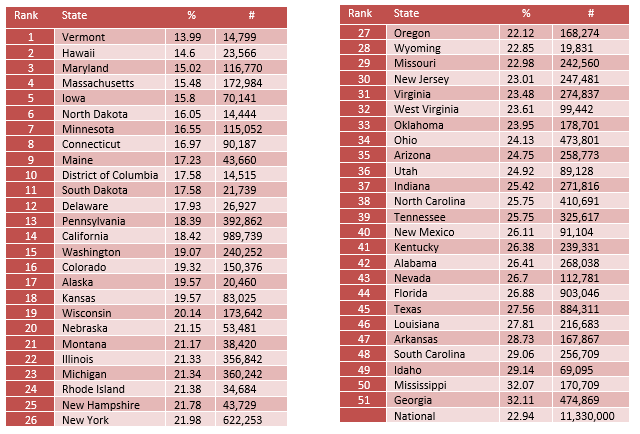Adults Rankings
States with high rankings have lower prevalence of mental illness and higher rates of access to care for adults. Lower rankings indicate that adults have higher prevalence of mental illness and lower rates of access to care.
The 7 measures that make up the Adult Ranking include:
- Adults with Any Mental Illness (AMI)
- Adults with Dependence or Abuse of Illicit Drugs or Alcohol
- Adults with Serious Thoughts of Suicide
- Adults with AMI who Did Not Receive Treatment
- Adults with AMI Reporting Unmet Need
- Adults with AMI who are Uninsured
- Adults with Disability Who Could Not See a Doctor Due to Costs
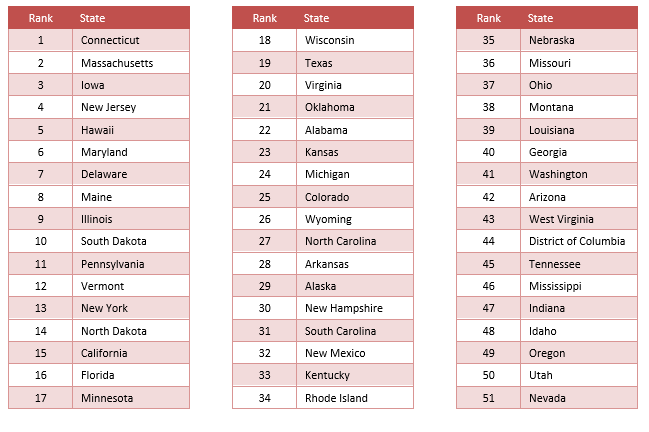
Adult Prevalence of Mental Illness - Adults with Any Mental Illness (AMI)
According to SAMHSA, “Any Mental Illness (AMI) is defined as having a diagnosable mental, behavioral, or emotional disorder, other than a developmental or substance use disorder. Any mental illness includes persons who have mild mental illness, moderate mental illness, and serious mental illness.
18.29% of adults struggle with a mental health problems annual. In numbers, this equals to 43.7 million Americans.
The state prevalence of mental illness ranges from 16.03% in Florida to 22.66% in Oregon.
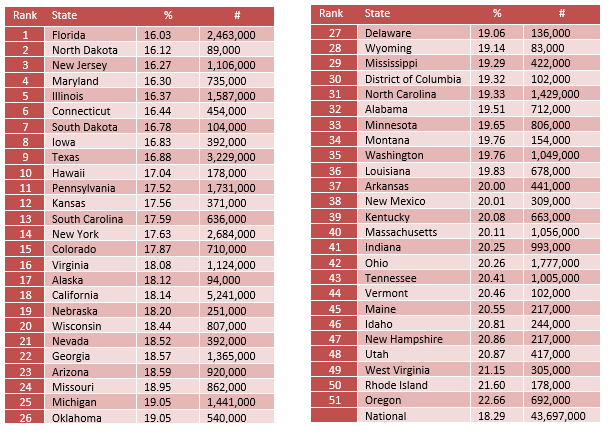
Adult with Dependence or Abuse of Illicit Drug or Alcohol
SAMHSA reports that the term “Illicit Drugs” includes marijuana/hashish, cocaine (including crack), heroin, hallucinogens, inhalants, or prescription-type psychotherapeutics used non-medically, including data from original methamphetamine questions but not including new methamphetamine items added in 2005 and 2006.
8.47% of adults in America report having a substance use or alcohol problem.
The state prevalence of adult alcohol and substance use ranges from 7.18% in Tennessee to 12.51% in Washington, DC.
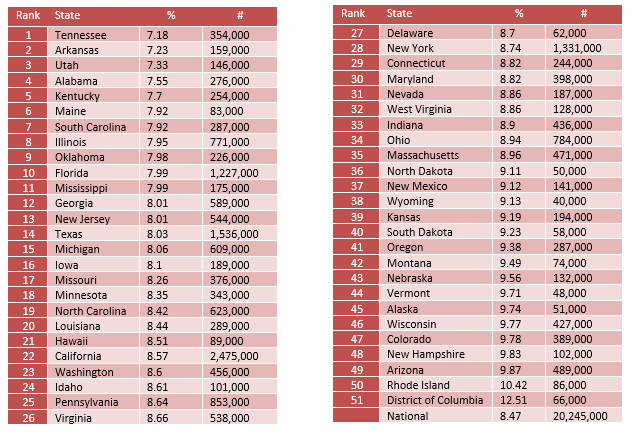
Adults with Serious Thoughts of Suicide
The percentage of adults reporting serious thoughts of suicide is 3.94%. The estimated number of adults with serious suicidal thoughts equals 9.4 million individuals.
The state prevalence of adult with serious thoughts of suicide range from Connecticut at 3.34% to Utah at 4.85%.
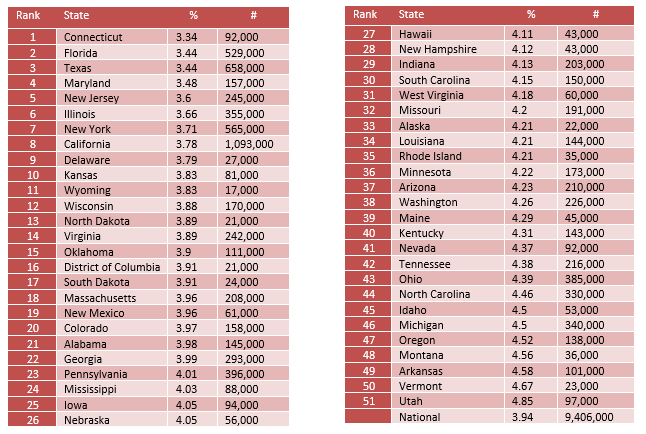
Adults with AMI who are Uninsured
17% (over 7.5 million) of adults with a mental illness remain uninsured.
With a national focus on health care access, the uninsured rate is improving.
In 2011, 19% of adults with a mental illness were uninsured.
Alabama, Louisiana, Oklahoma, and New Mexico had the largest increase in access to mental health coverage among adults.
Unfortunately, having insurance coverage does not mean access needed treatment.
56.5% of adults with mental illness received no past year treatment, and for those seeking treatment, 20.3% continue to report unmet treatment needs.
The state prevalence of uninsured adults with mental illness ranges from 2.7% in Massachusetts to 28.2% in Nevada.
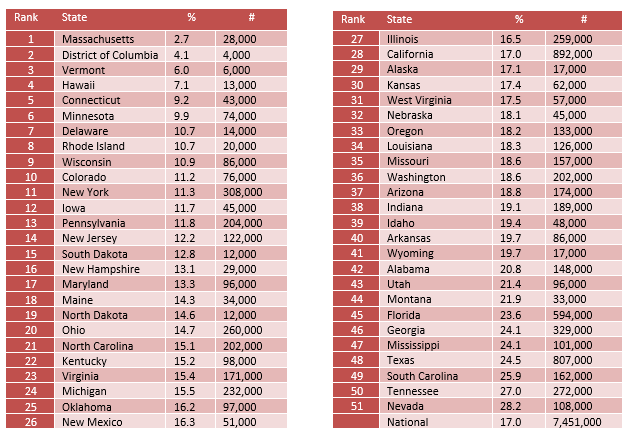
Adults with AMI who Did Not Receive Treatment
56.5% of adults with a mental illness received no treatment. Lack of access to treatment is slowly improving. In 2011, 59% of adults with a mental health problem did not receive any mental health treatment.
Reasons for not receiving treatment can be individual or systemic.
It is often the case that it takes time for people to recognize that what they are experiencing are symptoms of a mental health problem. 84% of the time between first symptoms and first treatment is spent not recognizing the symptoms of mental illness.6
Providing people with accessible and easy screening tools or encouraging primary care physicians to screen and ask about mental health problems are necessary in reducing untreated mental illness.
The state prevalence of untreated adults with mental illness ranges from 43.1% in Vermont to 67.5% in Nevada.
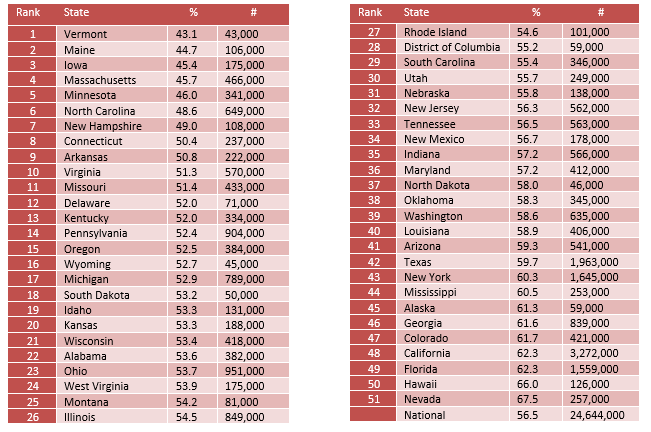
Adults with AMI Reporting Unmet Need
One out of five (20.3%) adults with a mental illness report they are not able to get the treatment they need.
States with the highest levels of unmet need (bottom 10) are 1.6 times more likely to have people report unmet need.
Unlike the number of people with mental illness who did not receive treatment, the individuals who are reporting unmet need are seeking treatment and facing barriers to getting the help they need.
Once a person recognizes that they may have a mental health problem, finding support especially the right kind of support is often difficult. Several systemic barriers to accessing care include:
- Lack of insurance or inadequate insurance
- Lack of available treatment providers
- Lack of available treatment types (inpatient treatment, individual therapy, intensive community services)
- Insufficient finances to cover costs – including, copays, uncovered treatment types, or when providers do not take insurance.
The state prevalence of adults with AMI reporting unmet treatment needs ranges from 13.6% in Hawaii to 25.9% in Missouri.
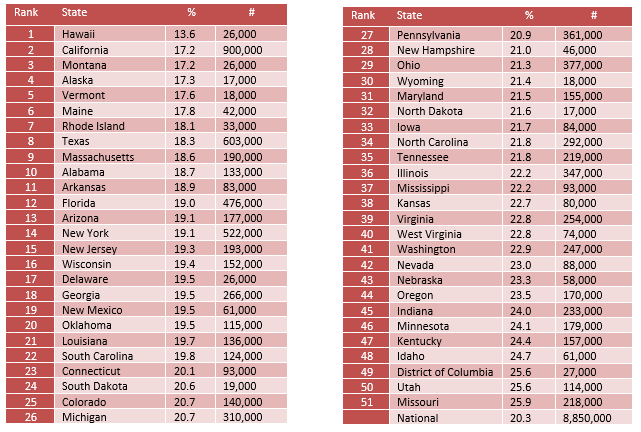
Adults with Disability Who Could Not See a Doctor Due to Costs
22.94% of adults with a disability were not able to see a doctor due to costs. The inability to pay for treatment, due to high treatment costs and/or inadequate insurance coverage remains a barrier for individuals despite being insured.
People with mental health problems have a 2.5 to 7 times greater odds of facing barriers to medical care and 50% of adults who have untreated need, didn’t receive treatment because of costs. These barriers include not having access to a primary care physician, not being able to get needed medical care, not having accesses to needed medication, and delayed medical treatment because of costs.2
The prevalence of adults with disability who couldn’t see a MD due to cost ranges from 13.99% in Vermont to 32.11% in Georgia.
